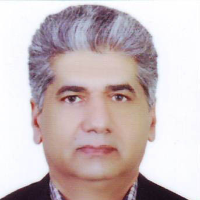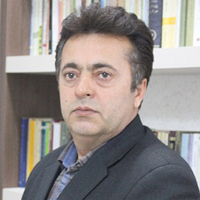Discovering an Important Historical Truth: The Presence of the God Bahram in the Rock Relief of the Large Grotto of Taq-i Bustan
The Sasanian rock reliefs reliefs has been repeatedly, seriously, expertly and completely studied by Iranian and non-Iranian archaeologists and researchers, however, there are remarkable different point of views in expressing the historical content of some of the rock reliefs, especially the identification of some of the characters. The reliefs of the large grotto of Taq-i Bustan known as Taq-i Bustan III (TB III) (Figures 1 and 2) are considered as the most controversial and challenging Sasanian rock relief, and the identity of its characters are not known with certainty and are still unclear. Some scholars attributed all of the rock reliefs of the large grotto of Taq-i Bustan to Piruz I. They believed that he wanted to show divine gifts given to him and his country. Some of the researchers and archaeologists attributed the king in the large grotto of Taq-i Bustan as Khusrow Parviz. The other researchers and archaeologists known the king in the large grotto of Taq-i Bustan as Ardashir III (For more studies see Mousavi Haji and Sarfaraz, 2017). By attributing all the rock reliefs of the large grotto of Taq-i Bustan to Piruz I, the authors of this article try to make clear the real identity of one of the characters present in the investiture relief of the large grotto of Taq-i Bustan. The character in question is situated at the right of the scene and to the left of Piruz I, and it appears he invested the royal ring to the Sassanid king (Figure 3). Although, most of the Iranian and non-Iranian scholars and archaeologists introduced him as the god Ahura Mazda, but according to historical sources, facial characteristics and symbol studies, the authors have no any doubt that he was the god Bahram, not the god Ahura Mazda. The most important aim of this article is to clarify the real identity of the character in question in the investiture scene of the Piruz I in the large grotto of Taq-i Bustan. Except Nosratallah Bokhtortash (1998) and overlaet (2011) that attributed the character in question in the investiture scene of Sasanian king in the large grotto of Taq-i Bustan as Mobadan Mobad, other scholars such as Herzfeld (2002), Sheppard (2008), Ghirshman (1975), Vanden Berghe (1984), Meshkati (1970), Scratto (2004), Sami (2010), Shahbazi (1389), Canepa (2013), Haerinck (1999), Azarpay (2000), Hermann (1977), Schmidt (1970), Mackintosh (1978), Tanabe (2003) believed that the Sasanian king in the investiture relief of Large grotto of Taq-i Bustan receiving the royal ring from the great god Ahura Mazda. However, these scholars do not provide a clear and convincing reason in justifying their attribution, and they introduced him as the god Ahura Mazda just on the basis of the fact that the act of investing the royal ring as the symbol of Farrah is performed only from the great god, and therefore he should be the god Ahura Mazda. On the contrary, Bokhtortash and overlaet criticized the archaeologists and orientalists who attributed the character of the investor person as the god Ahura Mazda, and instead they mentioned that the god Ahura Mazda has not appearance and can’t be seen. On the basis of this fact they believed that the person who invested the royal ring in this relief is Mobadan Mobad and not the god Ahura Mazda. The results of this study which are basic research in the view of the purpose and historical research in the view of the method, clearly show that the character in this rock relief should be the god Bahram and not the god Ahura Mazda. To prove this claim, the first the physical appearance and iconography characteristics of the god Ahura Mazda in all of the Sasanian rock reliefs were studied. The results of the study show that the character in question in this article could not be the god Ahura Mazda because in all of the rock reliefs, the god Ahura Mazda wear crenellated crown that the hair appeared above it. But in the rock relief of the Taq-i Bustan, the character in question did not wear crenellated crown. So this character did not have the most characteristic of the god Ahura Mazda i.e. the crenellated crown. In addition, the dress, mantle and trouser of the character in question in the rock relief of the large grotto of Taq-i Bustan have complete differences with the clothes of the god Ahura Mazda. In none of the images, the god Ahura Mazda wear a long mantle that covers the ankle. Therefore, from the point of view of clothing, it is completely different from the images of the god Ahura Mazda in all of the other rock reliefs. The other important point is the beard of this person. The god Ahura Mazda has a folded and open beard in all of the rock reliefs, but this person has a ring at the end of his beard that gathers his beard and makes it like a triangular. This feature is not only unprecedented in any of the surviving images of the god Ahura Mazda, but only seen in the images of the kings. In addition, the trouser of the god Ahura Mazda are not placed in long boots in any of the rock reliefs. In the Park Museum of Taq-i Bustan twelve Sasanian capitals were exhibited which have been collected from different parts of Kermanshah province and transferred to this historical site to preserve (Moradi, 2004). On these capitals, the images of the Sasanian king, various vegetal motifs and the image of several Zoroastrian gods are depicted, which among the Zoroastrian gods, the god Bahram depicted more than the other gods. On one of the capitals, the god Bahram is depicted with a three quarter face and frontal body with big eyes, wavy face moustache and curly beard (Figure 10). He wears a helmet that covers his head and neck completely. On the bottom of the helmet and in the forehead position, a strip consisting of two rows of circular beads is wrapped around the helmet. On top of the helmet, the curly strands of the hair appear, which was wrapped with an ornamental ribbon. On his shoulders, there are big circular globes. He wears a tight, pearl-embroidered dress with a cloak that covers the chest and arms and is fastened at the front by a circular button. He puts his left hand on his chest and puts his thumbs and index fingers on top of each other, and with his right hand, he holds up the royal ring, which symbolizes the Farrah of God (Ibid.). It is interesting to know that in many cases the iconographic characteristics of the god Bahram in this capital are comparable to the physical characteristics of the character in question in the rock relief of the large grotto of Taq-i Bustan. Both characters wear the same helmet, from which curly strands of hair appeared and are adorned with a wavy ribbon. Both characters have necklaces adorned with two strings of pearls around their necks and both of them wear a cloak that fastened with a button on the front of their chests. Both characters have large eyes and are placed circular globes on their shoulders (compare the Figure 10 with Figure 2). In addition to the physical characteristics and iconographical sources, there are other credible and reliable reasons that testify to the correct attribution of the character discussed in this article as the god Bahram. The main reasons are: - Historical sources and religious texts emphasize the close relationship between the god Bahram and its relationship with water and rain. The presence of the god Bahram in this rock relief testifies the companionship and cooperation of this god and the water goddess Anahita in overcoming the drought of Piruz I. The cooperation of the god Bahram and the goddess Anahita is so unprecedented that it has found its way into literature and has remained in the minds in the following years. -The main function of the god Bahram is victory in war. Therefore, his connection with water and rain, as well as his victory in the war, is completely in line with the two prominent events of Piruz I, i.e. the war and the drought, and makes his presence necessary. - The most important characteristic of the crown of Piruz I is the two wings of the eagle which is opened and it is regarded as the symbol of the god Bahram and shows the interest and belief of Piruz I. Even the name of this king is in complete harmony with the meaning of victory –which is the main function of the god Bahram.
- حق عضویت دریافتی صرف حمایت از نشریات عضو و نگهداری، تکمیل و توسعه مگیران میشود.
- پرداخت حق اشتراک و دانلود مقالات اجازه بازنشر آن در سایر رسانههای چاپی و دیجیتال را به کاربر نمیدهد.




